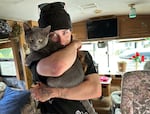
Kaylee, 23, spent most of her life in the state's custody. She is pictured in 2025 with her cat, which she rescued, in an RV in Cottage Grove where she sometimes crashes on the couch.
Lauren Dake / OPB
Kaylee has been through a lot since she was sent to a locked youth treatment center in St. George, Utah, six years ago.
But she can still remember the feeling she had during the emergency child welfare hearing when the judge approved a plan to send her to a facility out of state: panic.
“Oh, I lost my mind,” she said in a recent interview with OPB. “I started crying right there.”
Kaylee was part of a group of kids placed in Oregon’s foster care system who were sent out of state six years ago. Dozens of kids were scattered across 16 different states at the height of the practice. Some of the children were as young as 9.
After widespread stories of abuse — kids being restrained and assaulted, a riot breaking out — Oregon largely stopped the practice.
But now, the state is once again considering changing the law to make it easier to send children out of state. The controversial measure has Democrats, who are otherwise often aligned, divided. Supporters of the idea have promised this time will be different. Opponents have voiced concerns that it will ultimately mean more children are harmed.

This map from 2019 shows the number of times children in foster care were placed in residential treatment facilities out-of-state at that time. Some children went to more than one out-of-state facility.
Source: Oregon Department of Human Services / OPB
OPB is not including Kaylee’s full name to protect her from harm.
For Kaylee, stability has always been elusive. But before Utah, she had a network, a community. She knew if she was in Oregon, she could find someone to help her. After Utah, she never really got that back.
Kaylee now lives in the small rural timber town of Cottage Grove. She’s been crashing on people’s couches and floors and in their RVs, anything to avoid sleeping on the street.
“I hate never having a place to really call my own or if I leave for a few days, it probably won’t be there for me to come back to,” she said.
For Kaylee, Utah was one bad experience in a life of many. But if Utah was supposed to help, it didn’t. And the idea the state is considering sending kids out of state again, even with promises that it will be different, troubles her.
The bill
Around 2018, Oregon started relying more heavily on the practice of sending youth placed in foster care to residential treatment facilities out of state.
Oregon child welfare officials said they had dwindling options in the state where they could house children in foster care. They also said kids were being sent to facilities with unique programs to meet the specific needs of each child.
But one thing became clear: The farther away Oregon kids went, the more difficult it was for people back home to monitor their well-being.
Annette Smith, a lawyer who represented kids who were sent out of state the first time around, said when you send children across state lines, they often lose whatever community and connections they have.
“It makes it more difficult for people who love this child and care about this child to ensure their well-being on a daily basis,” Smith said.
State lawmakers who are in favor of House Bill 3835, a wide-ranging measure that also changes what is considered and when children can be restrained physically, have promised this time will be different.

State Rep. Rob Nosse, D-Portland, speaks on the House floor in 2024.
Dirk VanderHart / OPB
Rep. Rob Nosse, D-Portland, is the sponsor of the bill. In a recent interview on OPB’s “Think Out Loud,” Nosse defended the proposal. “It’s about sending someone out of state for medical treatment and (the bill then) requires them to come back once that medical treatment is completed.”
Democratic Gov. Tina Kotek has also thrown her weight behind the controversial bill, testifying that it would “improve youth access to behavioral health care.”
But the chairs of both the House and Senate Human Services Committees oppose the measure.
Sen. Sara Gelser Blouin, D-Corvallis, who chairs the senate committee, said if the state was only going to be sending kids to placements for medical reasons, that language should be clear in the bill.
“I’m on the side of I don’t believe them and everything they are saying isn’t in the bill,” Gelser Blouin said. “If they are going to medical placements, put it in the bill.”
The state’s Department of Human Services recently settled a civil child-welfare lawsuit and an expert was appointed to oversee the troubled system. The state’s child welfare system was also sued for placing kids in hotels. Individuals have also sued the state frequently over the mistreatment of kids placed in their care. In 2023, the state paid $40 million to settle a lawsuit after four children were sexually and physically abused by their foster parents.
“This is an agency under two federal court orders and who is bankrupting our state insurance fund with all these payouts for wrongful death and sexual abuse and civil rights violations,” Gelser Blouin said.

Oregon state Rep. Annessa Hartman (right) pictured in January 2025 speaking with state Rep. Kevin Mannix (left).
Kristyna Wentz-Graff / OPB
Rep. Annessa Hartman, D-Gladstone, who chairs the House Committee on Human Services and Housing, said she spent a lot of time speaking with providers and children placed in the system before making up her mind about the bill.
“To me, this bill, if passed, does not do what I would hope the state does and that’s figure out how to wrap around these kids and their families and give them the services they need and I don’t think this gets to that,” Hartman said, adding the bill does nothing to create more training or higher wages for those who work in residential facilities nor does it do anything to recruit more foster parents, both which would help with in-state placements.
As part of the recently settled class action lawsuit, the court-appointed expert is currently investigating the system and expected to report to the state Legislature within the coming weeks.
“Why would we make these sweeping changes (right before the expert) report back to us and provide policy recommendations?” Hartman said, “Why not just wait?”
The bill is currently in the House Committee on Rules.

The Oregon Department of Human Services in Salem. A massive bill to reform aspects of the foster care system is moving through the Legislature.
Bradley W. Parks / OPB
Kaylee now
Kaylee was essentially raised by the state of Oregon. She first entered foster care at age 4. She aged out at 21. All told, she said, she had 54 different placements.
When she heard the state might send kids out of state again, she quickly asked about how Oregon could keep the kids safe.
The concern is grounded in her history: While she was at Red Rock Canyon School, Oregon child welfare officials visited and returned with a flattering report of the place. The report noted kids in foster care could practice yoga, meditate and have plenty of opportunities to express themselves.
It described the facility, a former hotel in southwestern Utah, as having clean bedrooms, and each child having room by the bed where they can personalize their space.
The Oregon report stood in stark contrast to a much more critical picture revealed by a visit from Utah’s Department of Human Services. The two reports were issued within one day of each other. The state of Utah’s findings cite a list of violations at the facility, including staff humiliating and degrading residents and a youth being put into a chokehold until they were unconscious after he was involved in a physical altercation with a staff member.
While Kaylee was at the facility, a riot also erupted. A SWAT team arrived at the facility, with guns drawn. More than 20 kids were injured. In a separate incident at the facility, a staffer physically assaulted her.
Zephyr Berry, a 21-year-old who sits on the state’s System of Care Advisory Council, a group that helped craft this measure, said they believe this time will be different and the opponents haven’t spent enough time reading the measure.
Berry said they believe kids will only be sent out of state in serious cases when they need medical treatment and would otherwise die.
“From a youth perspective, this bill holds the state more accountable when and where and why a youth can be out of state,” Berry said. “It isn’t just that we don’t have space.”
Kaylee now spends her days searching for a job and hoping for a permanent place to call home. She mostly relies on federal food assistance and said she has about 23 cents to her name. She’s spent the past couple of weeks applying for fast-food jobs. On a recent visit with OPB, she grabbed lunch at Walmart. Before she asked for a ride back to the latest couch she’s calling home, she mentioned she could use some socks and underwear. I bought them for her.
For most of Kaylee’s life, family has been fleeting. Mostly made up of friends or people she has managed to stay in contact with for longer than usual.
Who is her family right now?
“I don’t know,” she said. “Probably no one.”